Related Research Articles

The Warsaw Ghetto was the largest of the Nazi ghettos during World War II and the Holocaust. It was established in November 1940 by the German authorities within the new General Government territory of occupied Poland. At its height, as many as 460,000 Jews were imprisoned there, in an area of 3.4 km2 (1.3 sq mi), with an average of 9.2 persons per room, barely subsisting on meager food rations. Jews were deported from the Warsaw Ghetto to Nazi concentration camps and mass-killing centers. In the summer of 1942, at least 254,000 ghetto residents were sent to the Treblinka extermination camp during Großaktion Warschau under the guise of "resettlement in the East" over the course of the summer. The ghetto was demolished by the Germans in May 1943 after the Warsaw Ghetto Uprising had temporarily halted the deportations. The total death toll among the prisoners of the ghetto is estimated to be at least 300,000 killed by bullet or gas, combined with 92,000 victims of starvation and related diseases, the Warsaw Ghetto Uprising, and the casualties of the final destruction of the ghetto.

A Judenrat was an administrative body established in German-occupied Europe during World War II which purported to represent a Jewish community in dealings with the Nazi authorities. The Germans required Jews to form Judenräte across the occupied territories at local and sometimes national levels.
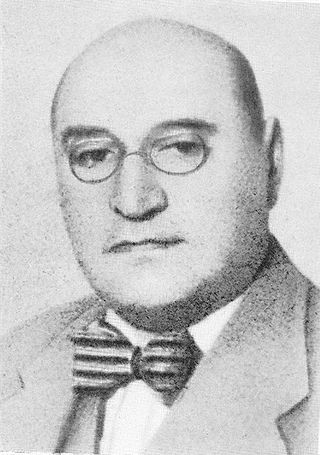
Adam Czerniaków was a Polish engineer and senator who was head of the Warsaw Ghetto Jewish Council (Judenrat) during World War II. He committed suicide on 23 July 1942 by swallowing a cyanide pill, a day after the commencement of mass extermination of Jews known as the Grossaktion Warsaw.
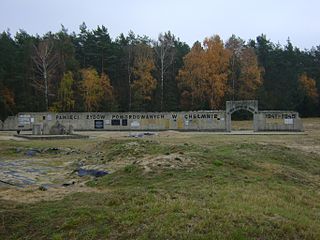
Chełmno or Kulmhof was the first of Nazi Germany's extermination camps and was situated 50 km (31 mi) north of Łódź, near the village of Chełmno nad Nerem. Following the invasion of Poland in 1939, Germany annexed the area into the new territory of Reichsgau Wartheland. The camp, which was specifically intended for no other purpose than mass murder, operated from December 8, 1941, to April 11, 1943, parallel to Operation Reinhard during the deadliest phase of the Holocaust, and again from June 23, 1944, to January 18, 1945, during the Soviet counter-offensive. In 1943, modifications were made to the camp's killing methods as the reception building had already been dismantled.
This is a selected bibliography and other resources for The Holocaust, including prominent primary sources, historical studies, notable survivor accounts and autobiographies, as well as other documentation and further hypotheses.

Chaim Mordechaj Rumkowski was the head of the Jewish Council of Elders in the Łódź Ghetto appointed by Nazi Germany during the German occupation of Poland.

Hans Biebow was the chief of German Nazi administration of the Łódź Ghetto in occupied Poland.

The Łódź Ghetto or Litzmannstadt Ghetto was a Nazi ghetto established by the German authorities for Polish Jews and Roma following the Invasion of Poland. It was the second-largest ghetto in all of German-occupied Europe after the Warsaw Ghetto. Situated in the city of Łódź, and originally intended as a preliminary step upon a more extensive plan of creating the Judenfrei province of Warthegau, the ghetto was transformed into a major industrial centre, manufacturing war supplies for Nazi Germany and especially for the Wehrmacht. The number of people incarcerated in it was increased further by the Jews deported from Nazi-controlled territories.
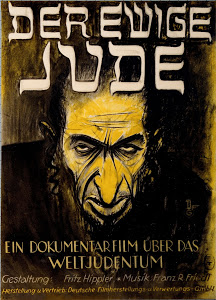
The Eternal Jew is a 1940 antisemitic Nazi propaganda film, presented as a documentary. The film's initial German title was Der ewige Jude, the German term for the character of the "Wandering Jew" in medieval folklore. The film was directed by Fritz Hippler at the insistence of Nazi Germany's Minister of Propaganda, Joseph Goebbels.
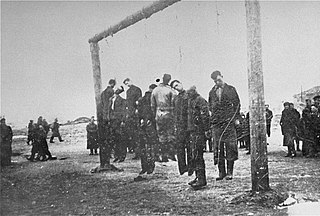
The Lwów Ghetto was a Nazi ghetto in the city of Lwów in the territory of Nazi-administered General Government in German-occupied Poland.

Jewish resistance under Nazi rule took various forms of organized underground activities conducted against German occupation regimes in Europe by Jews during World War II. According to historian Yehuda Bauer, Jewish resistance was defined as actions that were taken against all laws and actions acted by Germans. The term is particularly connected with the Holocaust and includes a multitude of different social responses by those oppressed, as well as both passive and armed resistance conducted by Jews themselves.

Lucille Eichengreen was a survivor of the Łódź (Litzmannstadt) Ghetto and the Nazi German concentration camps of Auschwitz, Neuengamme and Bergen-Belsen. She moved to the United States in 1946, married, had two sons and worked as an insurance agent. In 1994, she published From Ashes to Life: My Memories of the Holocaust. She frequently lectured on the Holocaust at libraries, schools and universities in the U.S. and Germany. She took part in a documentary from the University of Giessen on life in the Ghetto, for which she was awarded an honorary doctorate.

The Sixth Battalion is a 1998 documentary film that examines the history of Jewish soldiers who fought for the Slovak Republic, a puppet state created by Nazi Germany, during World War II. The documentary combines interviews with archival footage and photographs of the Slovak Republic in order to provide a brief history of the state, exploring the rise of antisemitism and how it affected these Jewish soldiers.

Who Shall Live and Who Shall Die is a 1982 documentary film that asks whether the United States could have stopped the Holocaust. The film combines previously classified information, rare newsreel footage, and interviews with the politicians who were in office at the time, to tell a behind-the-scenes story of secret motives and inane priorities that allowed for the death of millions. The film title refers to the prayer Unetanneh Tokef that has been a part of the Rosh Hashanah and Yom Kippur liturgy in rabbinical Judaism for centuries and is also remembered in Leonard Cohen's song Who by Fire.

Goodbye Holland is a 2004 documentary about the extermination of Dutch Jews during World War II. The film debunks the accepted notion that the Dutch were 'good' during the war, exposing how Dutch police and civil servants helped the German occupying regime implement massive deportations, which resulted in the death of 78 percent of the Jews in the Netherlands.

In the early modern era, European Jews were confined to ghettos and placed under strict regulations as well as restrictions in many European cities. The character of ghettos fluctuated over the centuries. In some cases, they comprised a Jewish quarter, the area of a city traditionally inhabited by Jews. In many instances, ghettos were places of terrible poverty and during periods of population growth, ghettos had narrow streets and small, crowded houses. Residents had their own justice system. Around the ghetto stood walls that, during pogroms, were closed from inside to protect the community, but from the outside during Christmas, Pesach, and Easter Week to prevent the Jews from leaving at those times.

Tarłów is a village in Opatów County, Świętokrzyskie Voivodeship, in south-central Poland. It is the seat of the gmina called Gmina Tarłów. It lies approximately 30 kilometres (19 mi) north-east of Opatów and 79 km (49 mi) east of the regional capital Kielce. It is approximately 13 kilometres (8 mi) north of the town of Ozarow. The village belongs to historic province of Lesser Poland.
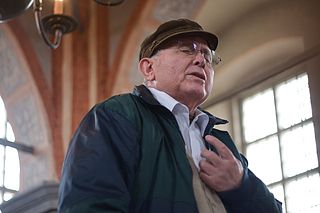
Pinchas Gutter is a Holocaust educator and frequent guest lecturer for the Sarah and Chaim Neuberger Holocaust Centre and the March of the Living and March of Remembrance and Hope programs. He is one of the pioneers of an innovative project called Dimensions in Testimony in which a life-sized interactive biography will be wheeled into classrooms, lecture halls and museums. The idea is that the audience asks questions and pre-recorded statements from the video Gutter will respond – much as if talking to the real person. Gutter has also been the subject of a number of films by directors such as Fern Levitt, Eli Rubenstein, Stephen D. Smith and Zvike Nevo.

In the best-known photograph taken during the 1943 Warsaw Ghetto Uprising, a boy holds his hands over his head while SS-Rottenführer Josef Blösche points a submachine gun in his direction. The boy and others hid in a bunker during the final liquidation of the ghetto, but they were caught and forced out by German troops. After the photograph was taken, all of the Jews in the photograph were marched to the Umschlagplatz and deported to Majdanek extermination camp or Treblinka. The exact location and the photographer are not known, and Blösche is the only person in the photograph who can be identified with certainty. The image is one of the most famous photographs of the Holocaust, and the boy came to represent children in the Holocaust, as well as all Jewish victims.
References
- ↑ Library Catalogue, The Story of Chaim Rumkowski and the Jews of Lodz a film by Peter Cohen and Bo Kuritzén (videorecording). University of Toronto.
- ↑ "Transcript for "Give Me Your Children"". United States Holocaust Memorial Museum, Washington, D.C., 2011. Retrieved: 21 December 2012.
- Corry, John (4 October 1984), "'Rumkowski and the Jews of Lodz'", The New York Times
- The Story of Chaim Rumkowski and the Jews of Lodz (1982), 1990–2007, retrieved 28 July 2015
- Story of Chaim Rumkowski and the Jews of Lodz, archived from the original on 8 February 2012, retrieved 28 July 2015
- The Story of Chaim Rumkowski and the Jews of Lodz at IMDb
- The Story of Cham Rumkowski and the Jews of Lodz reviewed by The Jewish Channel